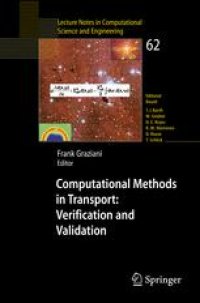
Ebook: Computational Methods in Transport: Verification and Validation
- Tags: Computational Science and Engineering, Theoretical Mathematical and Computational Physics, Astrophysics and Astroparticles, Appl.Mathematics/Computational Methods of Engineering
- Series: Lecture Notes in Computational Science and Engineering 62
- Year: 2008
- Publisher: Springer-Verlag Berlin Heidelberg
- Edition: 1
- Language: English
- pdf
The focus of this book deals with a cross cutting issue affecting all particle transport algorithms and applications; verification and validation (V&V). In other words, are the equations being solved correctly and are the correct equations being solved? Verification and validation assures a scientist, engineer or mathematician that a simulation code is a mirror of reality and not just an expensive computer game. In this book, we will learn what the astrophysicist, atmospheric scientist, mathematician or nuclear engineer do to assess the accuracy of their code. What convergence studies, what error analysis, what problems do each field use to benchmark and ascertain the accuracy of their transport simulations. Is there a need for new benchmark problems? Are there experiments that can be used to help validate the simulation results? If not, are there new experiments that could address these issues? These are all questions raised in this proceedings of the Second Computational Methods in Transport Workshop.
The focus of this book deals with a cross cutting issue affecting all particle transport algorithms and applications; verification and validation (V&V). In other words, are the equations being solved correctly and are the correct equations being solved? Verification and validation assures a scientist, engineer or mathematician that a simulation code is a mirror of reality and not just an expensive computer game. In this book, we will learn what the astrophysicist, atmospheric scientist, mathematician or nuclear engineer do to assess the accuracy of their code. What convergence studies, what error analysis, what problems do each field use to benchmark and ascertain the accuracy of their transport simulations. Is there a need for new benchmark problems? Are there experiments that can be used to help validate the simulation results? If not, are there new experiments that could address these issues? These are all questions raised in this proceedings of the Second Computational Methods in Transport Workshop.
The focus of this book deals with a cross cutting issue affecting all particle transport algorithms and applications; verification and validation (V&V). In other words, are the equations being solved correctly and are the correct equations being solved? Verification and validation assures a scientist, engineer or mathematician that a simulation code is a mirror of reality and not just an expensive computer game. In this book, we will learn what the astrophysicist, atmospheric scientist, mathematician or nuclear engineer do to assess the accuracy of their code. What convergence studies, what error analysis, what problems do each field use to benchmark and ascertain the accuracy of their transport simulations. Is there a need for new benchmark problems? Are there experiments that can be used to help validate the simulation results? If not, are there new experiments that could address these issues? These are all questions raised in this proceedings of the Second Computational Methods in Transport Workshop.
Content:
Front Matter....Pages I-X
Verification (Mostly) for High Energy Density Radiation Transport: Five Case Studies....Pages 1-17
A General Strategy for Physics-Based Model Validation Illustrated with Earthquake Phenomenology, Atmospheric Radiative Transfer, and Computational Fluid Dynamics....Pages 19-73
Spectral Solvers to Non-Conservative Transport for Non-Linear Interactive Systems of Boltzmann Type....Pages 75-104
The Art of Analytical Benchmarking....Pages 105-134
Implicit Monte Carlo Radiation Transport Simulations of Four Test Problems....Pages 135-150
The Prompt Spectrum of a Radiating Sphere: Benchmark Solutions for Diffusion and Transport....Pages 151-167
Some Verification Problems with Possible Transport Applications....Pages 169-175
Canopy Reflectance Model Benchmarking: RAMI and the ROMC....Pages 177-206
Uncertainty and Sensitivity Analysis for Models of Complex Systems....Pages 207-228
A Brief Overview of the State-of-the-Practice and Current Challenges of Solution Verification....Pages 229-250
Expert Panel Opinion and Global Sensitivity Analysis for Composite Indicators....Pages 251-275
A Practical Global Sensitivity Analysis Methodology for Multi-Physics Applications....Pages 277-299
Back Matter....Pages 301-326
The focus of this book deals with a cross cutting issue affecting all particle transport algorithms and applications; verification and validation (V&V). In other words, are the equations being solved correctly and are the correct equations being solved? Verification and validation assures a scientist, engineer or mathematician that a simulation code is a mirror of reality and not just an expensive computer game. In this book, we will learn what the astrophysicist, atmospheric scientist, mathematician or nuclear engineer do to assess the accuracy of their code. What convergence studies, what error analysis, what problems do each field use to benchmark and ascertain the accuracy of their transport simulations. Is there a need for new benchmark problems? Are there experiments that can be used to help validate the simulation results? If not, are there new experiments that could address these issues? These are all questions raised in this proceedings of the Second Computational Methods in Transport Workshop.
Content:
Front Matter....Pages I-X
Verification (Mostly) for High Energy Density Radiation Transport: Five Case Studies....Pages 1-17
A General Strategy for Physics-Based Model Validation Illustrated with Earthquake Phenomenology, Atmospheric Radiative Transfer, and Computational Fluid Dynamics....Pages 19-73
Spectral Solvers to Non-Conservative Transport for Non-Linear Interactive Systems of Boltzmann Type....Pages 75-104
The Art of Analytical Benchmarking....Pages 105-134
Implicit Monte Carlo Radiation Transport Simulations of Four Test Problems....Pages 135-150
The Prompt Spectrum of a Radiating Sphere: Benchmark Solutions for Diffusion and Transport....Pages 151-167
Some Verification Problems with Possible Transport Applications....Pages 169-175
Canopy Reflectance Model Benchmarking: RAMI and the ROMC....Pages 177-206
Uncertainty and Sensitivity Analysis for Models of Complex Systems....Pages 207-228
A Brief Overview of the State-of-the-Practice and Current Challenges of Solution Verification....Pages 229-250
Expert Panel Opinion and Global Sensitivity Analysis for Composite Indicators....Pages 251-275
A Practical Global Sensitivity Analysis Methodology for Multi-Physics Applications....Pages 277-299
Back Matter....Pages 301-326
....